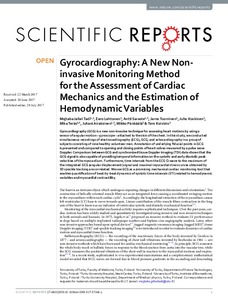Gyrocardiography: A New Non-invasive Monitoring Method for the Assessment of Cardiac Mechanics and the Estimation of Hemodynamic Variables
Saraste A; Koskinen J; Koivisto T; Tuominen J; Teras M; Tadi MJ; Pankaala M; Lehtonen E; Airaksinen J
Gyrocardiography: A New Non-invasive Monitoring Method for the Assessment of Cardiac Mechanics and the Estimation of Hemodynamic Variables
Saraste A
Koskinen J
Koivisto T
Tuominen J
Teras M
Tadi MJ
Pankaala M
Lehtonen E
Airaksinen J
NATURE PUBLISHING GROUP
Julkaisun pysyvä osoite on:
https://urn.fi/URN:NBN:fi-fe2021042717168
https://urn.fi/URN:NBN:fi-fe2021042717168
Tiivistelmä
Gyrocardiography (GCG) is a new non-invasive technique for assessing heart motions by using a sensor of angular motion - gyroscope - attached to the skin of the chest. In this study, we conducted simultaneous recordings of electrocardiography (ECG), GCG, and echocardiography in a group of subjects consisting of nine healthy volunteer men. Annotation of underlying fiducial points in GCG is presented and compared to opening and closing points of heart valves measured by a pulse wave Doppler. Comparison between GCG and synchronized tissue Doppler imaging (TDI) data shows that the GCG signal is also capable of providing temporal information on the systolic and early diastolic peak velocities of the myocardium. Furthermore, time intervals from the ECG Q-wave to the maximum of the integrated GCG (angular displacement) signal and maximal myocardial strain curves obtained by 3D speckle tracking are correlated. We see GCG as a promising mechanical cardiac monitoring tool that enables quantification of beat-by-beat dynamics of systolic time intervals (STI) related to hemodynamic variables and myocardial contractility.
Kokoelmat
- Rinnakkaistallenteet [19218]
